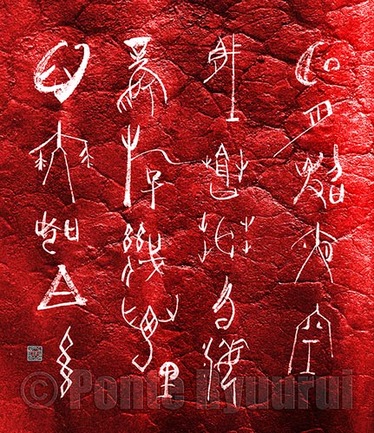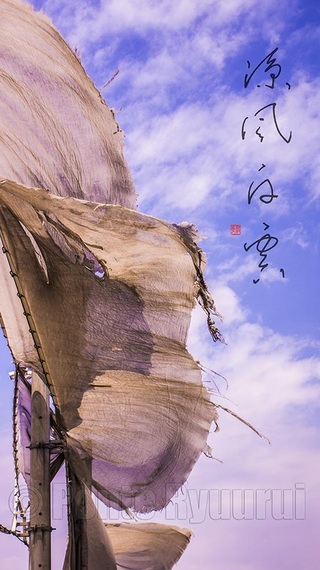 Today I was writing a calligraphy for an upcoming exhibition in Ginza, Tokyo. It is a quite important event, and it is so for two reasons. One is that Ginza is probably the most prestigious place that pone can display his or her art, and two, the exhibition is to celebrate 50 years of teaching career of my calligraphy teacher, Master Kajita Esshuu (梶田越舟, 1938 - present). Since he dislikes exhibitions and public spectacles, it makes this event even more special. So I wrote a few copies in "hard core" oracle bone script (甲骨文), and suddenly I decided to go bananas. I made my own semi-cursive version of 3500 years old script. And why not? It is quite interesting to mix and match the ancient script with another that evolved nearly 1500 years later. A wise Chinese ink painter, Shi Tao (石涛 1642-1710), once said "ink and brush should follow the times". I think they just did. Master the basics, master the scripts, and let your brush take over. Calligraphy is based on strict rules, that is true, but it is an art. All the greatest handwriting styles were created by those who dared to venture into the unknown. Poem (of my authorship, inspired by a poem by Li Bai): Bright moon illuminated the night skies Concealed in haze of vast sea of clouds Wind that travelled a few thousand miles Fluttered my mind light as silk 明月照夜空 藏蒼茫雲海 風游幾萬里 心舞如白糸  When I started to study photography in greater depth, I realised how much it has in common with the art of Chinese or Japanese calligraphy. Photography is all about light, composition, negative and positive space ratio, a message it carries, impact of the image on a viewer, and story telling via the personal style of a photographer. But what about calligraphy? Well, the balance between the ink and white paper space counts for the negative and positive space, then we have the Chinese characters carrying a message. While the energy and power of the brush strokes catches the viewer's attention, the calligrapher's skill and personality defines the originality of given calligraphy. However, photography, similarly to the majority of Western painting styles, is speaking through an image that is far more easily recognisable by the audience. We see a photography or a painting, and we immediately link what we see to real life objects or situations we encountered. On the other hand, Chinese calligraphy can be quite intimidating for many reasons. It is not only extremely abstract, but also unreadable for most of the people, even including the native speakers (especially the younger generation). I am often asked, if I can understand all the ancient masterpieces that I study. No I do not. Only those who study Chinese calligraphy in depth know, that the secret to understanding calligraphy art is not being able to read or translate the text, but to read it without reading. In other words, being able to read the energy of the brush strokes, or to be entranced by the white space. Those are the elements that speak to me from a calligraphy masterpiece, not the words. The combination of calligraphy and photography arts is a perfect duo. It conveys a message in both abstract and more literal form. I also believe that it serves perfectly as a bridge, between what the eyes can recognise, and what only soul can read. It is not only a fantastic aestethical journey, but also a mutual educational experience (between the artsit and the audience). Calligraphy text: 涼風白雲 (cool breeze and white clouds) |
Categories
All
AuthorPonte Ryuurui (品天龍涙) Archives
August 2020
|

 RSS Feed
RSS Feed